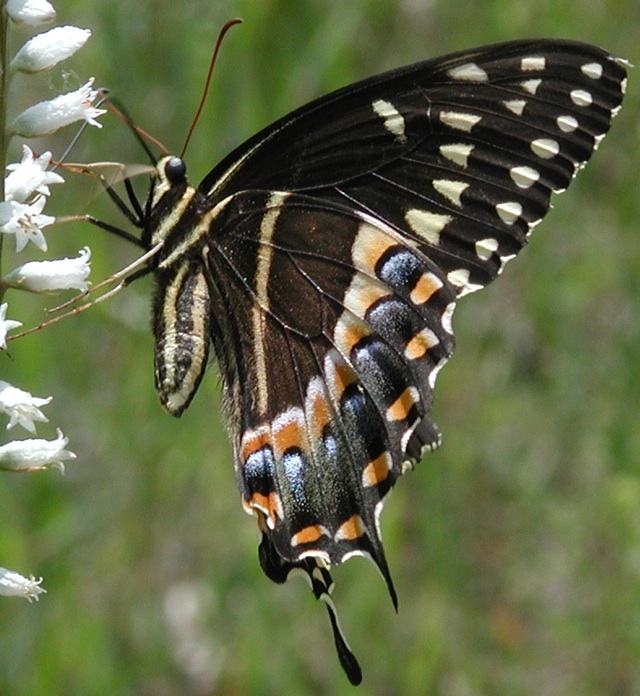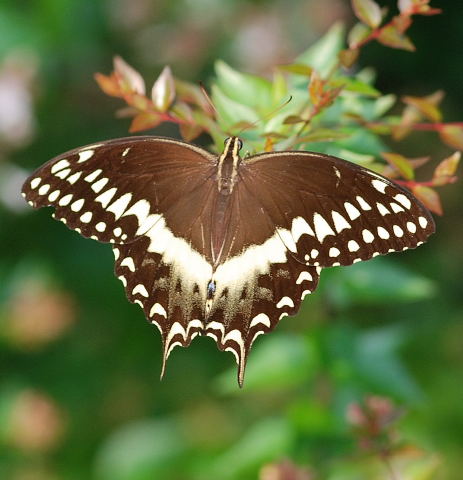|
| Common Name | Palamedes Swallowtail by Randy Newman => Fort Macon State Park, 2003-06-27
[View PDF]
 Click to enlarge Click to enlarge
[Google Images] GBIF [Global Distribution ] BoA [Images ] iNaturalist |
| Scientific Name | Pterourus palamedes
|
| Link to BAMONA species account. |
| Map | Click on a county for list of all database records for the species in that county.
 |
| Distribution | DISTRIBUTION: Throughout the Coastal Plain, but only a stray (presumably) to the eastern and southern edges of the Piedmont, and an accidental stray to the Mountains (two counties). Occurs in practically all Coastal Plain counties in NC, but scarce in the northwestern Coastal Plain.
|
| Abundance | ABUNDANCE: Common to abundant; abundant in many lower Coastal Plain counties with extensive pocosins and swamps. Dozens to over 100 individuals may be seen in a single day in some places, such as mainland Dare County, the Great Dismal Swamp, and in the Green Swamp.
|
| Flight | FLIGHT PERIOD: Mid-March into mid-October; rarely in early March and even into December (in a very mild fall). It is normally the latest flying swallowtail in fall. Probably two broods; mid-March to late June or early July, and early July to mid-October. There is no gap, however, between the flight periods.
|
| Habitat | HABITAT: Very widespread, but generally near swamps, pocosins, bay forests, savannas, and other moist forests. Not as common in dry places such as xeric longleaf pine forests. Not usually seen in deep shade, but often seen flying across fields, roads, and other openings.
|
|
| | Plants | FOOD AND NECTAR PLANTS: The main foodplant is Swamp Redbay (Tamala palustris = Persea palustris); the uncommon Upland Redbay (Tamala borbonia = Persea borbonia) is presumably used, as well. It is not clear if the related Sassafras (Sassafras albidum) is used. Swamp Redbay is abundant in most moist forests and pocosins in the Coastal Plain. The nectar plants are widespread; the butterfly is common at savanna plants such as blazing-stars (Liatris spp.) and thistles (Cirsium spp.).
|
| Comments | COMMENTS: This is often the most common and conspicuous butterfly seen on a day's visit to savannas, pocosins, and swamp roads in the Coastal Plain. It is a tame species allowing close approach while nectaring; it is also a rather slow flying species, such that large numbers are hit and killed by cars driving through the Green Swamp and through the Alligator River National Wildlife Refuge. The most remarkable record for the state was one photographed by John Gerwin on May 23, 2010, along the Blue Ridge Parkway in Jackson County, at close to 6000 feet!
Only in the past few decade has there been a disastrous die-off of Redbay trees in FL, GA, and now in southern and coastal SC; and within this period some death of Redbay trees has been noted in southeastern NC. Most such trees are now dead around Hilton Head Island, SC. An introduced beetle, native to Asia, along with a fungus, are the cause of the death, though there is some question about which organism first attacks the healthy tree. This death of large areas of Redbay has caused NatureServe to upgrade the Global Rank of the Palamedes Swallowtail from G5 (demonstrably secure) to G4 (apparently secure). Even though the butterfly remains abundant in most of its range in the Carolinas (for now), and no decline has yet been noted in NC (except maybe around Wilmington), the State Rank has been upgraded to S4 to be "in-line" with the Global Rank. Also, it is expected that the closely related Sassafras plant may well be impacted, which could impact not only the Palamedes Swallowtail but the Spicebush Swallowtail.
|
State Rank | S4 | | State Status | |
Global Rank | G4 | | Federal Status | |
| Synonym | Papilio palamedes
|
| Other Name |
|
|
|

 >>
>>

